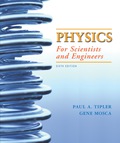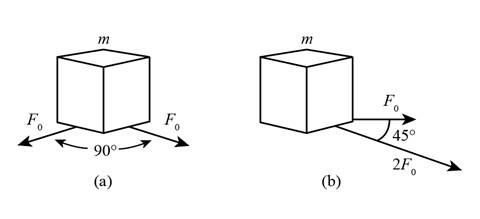
The magnitude of the acceleration of object for the given figures.
Answer to Problem 37P
The magnitude of the acceleration of object for case (a) is
Explanation of Solution
Given:
The given diagram is shown in Figure 1.

Figure 1
The acceleration when it acts on object on frictionless surface is,
Formula used:
The expression for the force is given by,
Here,
The net force acting on object due to
The net force acting on object due to
Calculation:
The value of the force is calculated as,
For the case (a),
The net force acting on object due to
The value of the acceleration is calculated as,
For the case (b),
The net force acting on object due to
The value of the acceleration is calculated as,
Conclusion:
Therefore, the magnitude of the acceleration of object for case (a) is
Want to see more full solutions like this?
Chapter 4 Solutions
EBK PHYSICS FOR SCIENTISTS AND ENGINEER
- A 3.00-kg block starts from rest at the top of a 30.0 incline and slides a distance of 2.00 m down the incline in 1.50 s. Find (a) the magnitude of the acceleration of the block, (b) the coefficient of kinetic friction between block and plane, (c) the friction force acting on the block, and (d) the speed of the block after it has slid 2.00 m.arrow_forwardA 7.3 kg crate is moved rightward across a horizontal surface by a horizontal force such that it has constant velocity. If the coefficient of the kinetic friction is 0.58, calculate the magnitude of the kinetic friction force.arrow_forwardA block of mass m is initially at rest on a frictionless surface at the origin. At t═0 a decreasing force of acts on it. Determine the equations of x (t) and v(t) at any time t given that x= 20mand v= 12m/s at t = 0arrow_forward
- A person in a kayak starts paddling, and it accelerates from 0 to 0.8 mile/hour in adistance of 0.8km. If the combined mass of the person and the kayak is 80kg, whatis the magnitude of the net force acting on the kayak?arrow_forwardThe force of friction always acts at an angle of 180 degrees relative to the motion of the object. True or Falsearrow_forwardTwo blocks, of weights 2.5 N and 5.6 N, are connected by a massless string and slide down a 30° inclined plane. The coefficient of kinetic friction between the lighter block and the plane is 0.081; that between the heavier block and the plane is 0.40. Assuming that the lighter block leads, find (a) the magnitude of the acceleration of the blocks and (b) the tension in the string.arrow_forward
- A dog and a sledge are on the frictionless ice of a frozen lake, 14.4 m apart but connected by a rope of negligible mass. The dog exerts a certain horizontal force (N) on the rope. If magnitudes of the sledge and the dog accelerations are 0.5 m/s² and 0.1 m/s?, respectively. How far from the dog's initial position (m) do they meet?arrow_forwardA crate of mass 50 kg slides on a horizontal floor under the action of an applied horizontal force of 200 N and against a friction force of 120 N. Calculate (a) the acceleration, and (b) the applied horizontal force required to give the same acceleration with twice the mass and half the friction.arrow_forwarda person in kayak atarts padding, and it accelarates from 0 to 0.474 m/s in a distance of 0.584 m. if the combined mass of the person and the kayak is 69.9kg, what is the magnitude of the net force acting on the kayak?arrow_forward
- an object of a mass 1.00kg is observed to have an acceleration with a magnitude of 10.0m/s^2 in a direction 60.0 degree east of north.the force f2 acting on the object has a magnitude 5.00N and its directed north.determine the magnitude and direction of the one other horizontal force.arrow_forwardA constant horizontal force F of magnitude 0.1 N is applied to m1. If m1 = 1.0 kg and m2 = 0.33 kg, find the magnitude of the acceleration of the system of two blocks.arrow_forwardIf the force acting on an object triples, what happens to the acceleration of the object? (the mass is unchanged) A. The acceleration is always 9.8 m/s/s B. The acceleration becomes zero C. The acceleration also triplesarrow_forward
 Physics for Scientists and Engineers with Modern ...PhysicsISBN:9781337553292Author:Raymond A. Serway, John W. JewettPublisher:Cengage Learning
Physics for Scientists and Engineers with Modern ...PhysicsISBN:9781337553292Author:Raymond A. Serway, John W. JewettPublisher:Cengage Learning Principles of Physics: A Calculus-Based TextPhysicsISBN:9781133104261Author:Raymond A. Serway, John W. JewettPublisher:Cengage Learning
Principles of Physics: A Calculus-Based TextPhysicsISBN:9781133104261Author:Raymond A. Serway, John W. JewettPublisher:Cengage Learning

